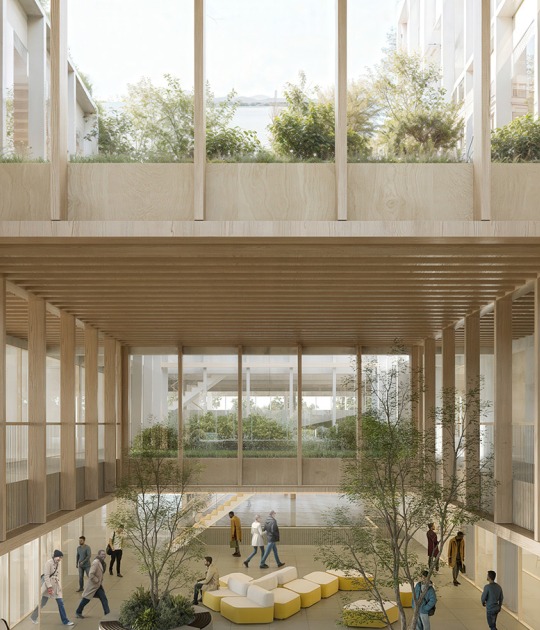Located just south of the iconic open space on the Johns Hopkins campus known as “The Beach” at the intersection of 33rd and Charles Streets, the facility will foster greater connectivity between the campus and the neighboring Charles Village community by creating a prominent, welcoming new entry point at 33rd Street. It will turn an area of the campus into a dynamic hub at the crossroads of student activity. As a natural gateway, the area will connect Charles Village and more than 3,500 Hopkins students who live in the neighborhood, to the heart of the Homewood campus.
The Village is conceived as a central living room surrounded by a collection of spaces tailored to the needs of the Hopkins community. The building negotiates the sloping grade of the site to allow direct entry from all four levels of the building, while maintaining a friendly human scale and providing several accessible routes across the site. Arriving on Charles Street, students and visitors are greeted by an open building façade with dining areas spilling out onto a sun-splashed plaza.
The entrance of The Village opens into a cascading interior landscape of dining, performance, lounging, and socializing. The mass timber structure provides a warm and acoustically comfortable environment as light filters in between the photovoltaic roof panels—features that help to meet the university’s larger sustainability goals.
An indoor landscape—as vast as the Beach next door—is comprised of a cluster of flexible spaces, which open out on to four rejuvenated public spaces: an events-focused commons, the shaded paths of the Grove, an entry plaza at 33rd street, and a new food market and plaza to the south. The signature red brick paths of Homewood campus seamlessly flow through the building.
The Village transforms the landscape around the building to create outdoor spaces for student activities and events. A central plaza can host pop-up exhibits or performances, as well as vendors and food trucks to enliven the North Charles Street corridor.
The open design allows light to enter the clerestory windows and leaves all student activities and school spirit on display. The Village becomes an ever-changing mosaic of the Johns Hopkins Community, and a village greater than the sum of its parts.
The new Hopkins Student Center is set to begin construction in Spring 2022 and to be completed by Fall 2024. This is BIG’s third academic building in the United States, following the Isenberg School of Management Business Innovation Hub for the University of Massachusetts Amherst and The Heights Building for Arlington Public Schools, both completed in 2019.




























